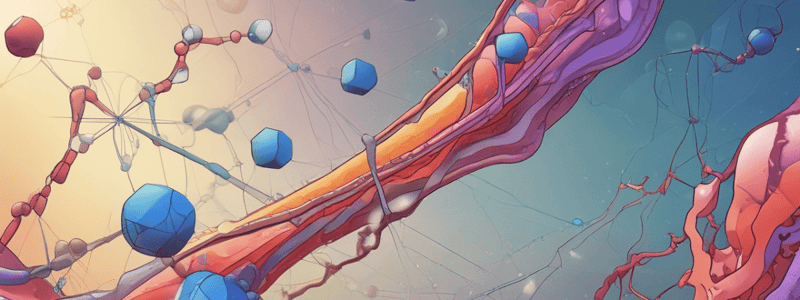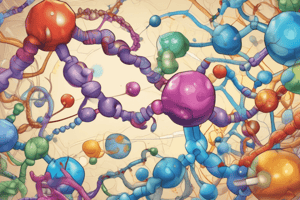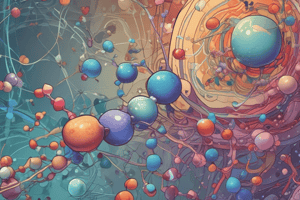Podcast
Questions and Answers
What is the percentage of nitrogen in proteins that differentiates them from carbohydrates and lipids?
What is the percentage of nitrogen in proteins that differentiates them from carbohydrates and lipids?
What type of bond is formed between the carboxyl group of one amino acid and the amino group of another amino acid?
What type of bond is formed between the carboxyl group of one amino acid and the amino group of another amino acid?
Which level of protein structure involves the formation of alpha helixes and beta sheets?
Which level of protein structure involves the formation of alpha helixes and beta sheets?
What is the term for the end of a protein structure with a free amino group?
What is the term for the end of a protein structure with a free amino group?
Signup and view all the answers
What is the term for the interactions between the R groups of amino acids that fold a polypeptide chain into a three-dimensional structure?
What is the term for the interactions between the R groups of amino acids that fold a polypeptide chain into a three-dimensional structure?
Signup and view all the answers
What is the level of protein structure that involves the binding of two or more folded polypeptide chains?
What is the level of protein structure that involves the binding of two or more folded polypeptide chains?
Signup and view all the answers
What function do some cellular proteins perform?
What function do some cellular proteins perform?
Signup and view all the answers
What is the primary site of plasma protein synthesis?
What is the primary site of plasma protein synthesis?
Signup and view all the answers
What happens to amino acids when proteins degrade?
What happens to amino acids when proteins degrade?
Signup and view all the answers
What is the function of collagen?
What is the function of collagen?
Signup and view all the answers
What is the result of cytokines released at the site of injury or inflammation?
What is the result of cytokines released at the site of injury or inflammation?
Signup and view all the answers
What is the function of enzymes?
What is the function of enzymes?
Signup and view all the answers
What is the primary function of immunoglobulins?
What is the primary function of immunoglobulins?
Signup and view all the answers
Which of the following conditions may cause hyperproteinemia?
Which of the following conditions may cause hyperproteinemia?
Signup and view all the answers
What is prealbumin an indicator of?
What is prealbumin an indicator of?
Signup and view all the answers
What is a possible cause of hypoproteinemia?
What is a possible cause of hypoproteinemia?
Signup and view all the answers
What is albumin responsible for in the blood?
What is albumin responsible for in the blood?
Signup and view all the answers
Which protein is synthesized in the liver and has the highest concentration of all plasma proteins?
Which protein is synthesized in the liver and has the highest concentration of all plasma proteins?
Signup and view all the answers
Which protein is involved in the removal of free hemoglobin?
Which protein is involved in the removal of free hemoglobin?
Signup and view all the answers
What is the primary function of ceruloplasmin?
What is the primary function of ceruloplasmin?
Signup and view all the answers
In which condition is α2-macroglobulin decreased?
In which condition is α2-macroglobulin decreased?
Signup and view all the answers
What is the primary function of transferrin?
What is the primary function of transferrin?
Signup and view all the answers
What is C-reactive protein (CRP)?
What is C-reactive protein (CRP)?
Signup and view all the answers
Which of the following is an immunoglobulin?
Which of the following is an immunoglobulin?
Signup and view all the answers
What is the principle behind refractometry in protein analysis?
What is the principle behind refractometry in protein analysis?
Signup and view all the answers
What is the complex formed in the biuret method?
What is the complex formed in the biuret method?
Signup and view all the answers
What is the purpose of the Kjeldahl technique?
What is the purpose of the Kjeldahl technique?
Signup and view all the answers
What is the principle behind the dye binding technique?
What is the principle behind the dye binding technique?
Signup and view all the answers
What is the pH of the buffer used in serum protein electrophoresis?
What is the pH of the buffer used in serum protein electrophoresis?
Signup and view all the answers
What is the term for the technique that separates proteins based on their size and charge?
What is the term for the technique that separates proteins based on their size and charge?
Signup and view all the answers
Study Notes
Characteristics of Proteins
- Proteins are macromolecules made of amino acids, linked via peptide bonds.
- Proteins consist of 16% nitrogen, differentiating them from carbohydrates and lipids.
- N-terminal: End of protein structure with a free amino group.
- C-terminal: End of protein structure with a free carboxyl group.
Protein Structure
- Primary structure: Amino acids linked through covalent peptide bonding in a specific sequence.
- Secondary structure: Polypeptide chain winds to form alpha helixes and beta sheets through hydrogen bonds.
- Tertiary structure: Coiled polypeptide chain folds to form a 3D structure through R group interactions.
- Quaternary structure: Two or more folded polypeptide chains bind to form a functional protein.
Types of Proteins
- Antibodies: Proteins that protect the body against "foreign" invaders.
- Cellular proteins: Function as receptors for hormones.
- Structural proteins: Collagen is the fibrous component that maintains body structure.
- Enzymes: Catalysts that accelerate chemical reactions.
Plasma Total Protein Regulation
- The liver synthesizes most plasma proteins.
- Plasma cells synthesize immunoglobulins.
- Proteins are synthesized from amino acids, with one amino acid linked to another through peptide bond formation.
- When proteins degrade, their constituent amino acids undergo deamination with ammonia formation, converted to urea for excretion in urine.
Clinical Significance of Major Proteins
- Prealbumin (Transthyretin): Indicator of nutritional status, transports thyroid hormones.
- Albumin: Synthesized in the liver, binds many analytes for transport, contributes to plasma osmotic pressure.
- α1-Acid glycoprotein (orosomucoid): Acute-phase reactant, binds to basic drugs.
- Haptoglobin: α2-globulin that binds free hemoglobin, acute-phase reactant.
- Ceruloplasmin: α2-globulin, copper-containing protein with enzymatic activity, acute-phase reactant.
- α2-Macroglobulin: Proteolytic enzyme inhibitor, increased in nephrotic syndrome, contraceptive use, pregnancy, and estrogen therapy.
- Transferrin: β-globulin that transports iron.
- C-Reactive Protein (CRP): β-globulin, acute-phase reactant, increased in tissue necrosis, infections, and inflammation.
- Immunoglobulins: Antibodies, synthesized in plasma cells as an immune response.
Methodology for Serum Total Protein, Albumin, and Protein Fractionation
- Refractometry: Based on the change in velocity of light, proportional to the concentration of solutes (proteins) present in serum.
- Biuret method: Based on cupric ions complexing with peptide bonds in an alkaline medium, producing a purple-colored complex.
- Dye binding: Proteins bind to a dye, forming a protein-dye complex that results in a shift of the maximum absorbance of the dye.
- Kjeldahl: Based on the quantification of the nitrogen content of protein, considered the reference method of choice.
- Electrophoresis: Serum protein electrophoresis, serum is applied in the cathode region of an agarose gel or cellulose acetate plate saturated with a buffer of pH 8.6.
Studying That Suits You
Use AI to generate personalized quizzes and flashcards to suit your learning preferences.
Description
Test your understanding of proteins and non-protein compounds in clinical chemistry. This quiz covers the characteristics of proteins, including their structure and bonding.




